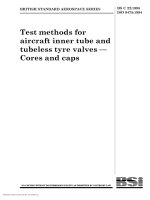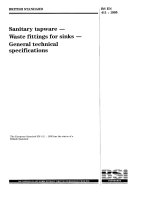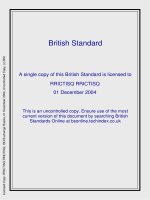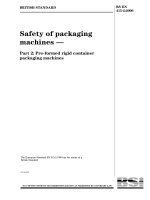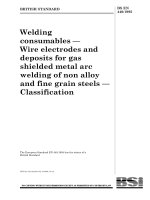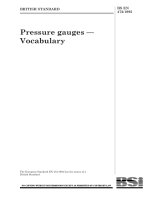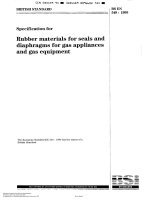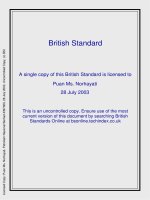Bsi bs en 61265 1995 (2000)
Bạn đang xem bản rút gọn của tài liệu. Xem và tải ngay bản đầy đủ của tài liệu tại đây (382.46 KB, 18 trang )
BRITISH STANDARD
Electroacoustics —
Instruments for
measurement of
aircraft noise —
Performance
requirements for
systems to measure
one-third-octave band
sound pressure levels in
noise certification of
transport-category
aircraft
The European Standard EN 61265:1995 has the status of a
British Standard
BS EN
61265:1995
IEC 1265:1995
BS EN 61265:1995
Committees responsible for this
British Standard
The preparation of this British Standard was entrusted to Technical
Committee EPL/29, Electroacoustics, upon which the following bodies were
represented:
British Association of Otolaryngologists
British Hearing Aid Industry Association
British Medical Association
British Society of Audiology
British Telecommunications plc
Confederation of British Industry
Department of Health
Department of Trade and Industry (National Physical Laboratory)
Health and Safety Executive
Institute of Acoustics
Institute of Sound and Vibration Research
Institute of Electrical Engineers
Medical Research Council
Ministry of Defence
Royal Aeronautical Society
Royal National Institute for Deaf people
Society of Environmental Engineers
University of Exeter
This British Standard, having
been prepared under the
direction of the Electrotechnical
Sector Board, was published
under the authority
of the Standards
Board and comes
into effect on
15 October 1995
Amendments issued since publication
© BSI 01-2000
Amd. No.
The following BSI references
relate to the work on this
standard:
Committee reference EPL/29
Draft for comment 93/208508 DC
ISBN 0 580 24583 7
Date
Comments
BS EN 61265:1995
Contents
Committees responsible
National foreword
Foreword
Text of EN 61265
List of references
© BSI 01-2000
Page
Inside front cover
ii
2
3
Inside back cover
i
BS EN 61265:1995
National foreword
This British Standard has been prepared by Technical Committee EPL/29 and is
the English language version of EN 61265:1995, Electroacoustics — Instruments
for measurement of aircraft noise — Performance requirements for systems to
measure one-third-octave band sound pressure levels in noise certification of
transport-category aircraft, published by the European Committee for
Electrotechnical Standardization (CENELEC). It is identical with
IEC 1265:1995, and supersedes BS 5647:1979, Specification for electro-acoustical
measuring equipment for aircraft noise certification, which is withdrawn.
Cross-references
Publication referred to
Corresponding British Standard
IEC 50(801):1994
BS 4727 Glossary of electrotechnical, power,
telecommunication, electronics, lighting and colour
terms
Part 3 Terms particular to telecommunications and
electronics
Group 08:1995 Acoustics and electroacoustics
BS EN 60801 Electromagnetic compatibility for
industrial-process measurement and control equipment
Part 2:1993 Electrostatic discharge requirements
BS 6667 Electromagnetic compatibility for
industrial-process measurement and control equipment
Part 3:1985 Method of evaluating susceptibility to
radiated electromagnetic energy
BS 7189:1989 Specification for sound calibrators
EN 60801-2:1993
(IEC 801-2:1991)
HD 481.3 S1:1987
(IEC 801-3:1984)
HD 556 S1:1991
(IEC 942:1988)
NOTE IEC 1094-3; IEC 1094-4 and IEC 1260 to which normative reference is made in the text have
each been circulated as Draft International Standards with parallel CENELEC vote and are expected
to be published in the near future as IEC Standards with corresponding EN and BS EN Publications.
A British Standard does not purport to include all the necessary provisions of a
contract. Users of British Standards are responsible for their correct application.
Compliance with a British Standard does not of itself confer immunity
from legal obligations.
Summary of pages
This document comprises a front cover, an inside front cover, pages i and ii,
the EN title page, pages 2 to 12, an inside back cover and a back cover.
This standard has been updated (see copyright date) and may have had
amendments incorporated. This will be indicated in the amendment table on the
inside front cover.
ii
© BSI 01-2000
EUROPEAN STANDARD
EN 61265
NORME EUROPÉENNE
April 1995
EUROPÄISCHE NORM
ICS 17.140.50 49.020
Descriptors: Electroacoustics, acoustic measuring instruments, acoustic measurements, noise sound, aircraft, sound pressure, level
quantity, certification, characteristics, specifications
English version
Electracoustics
Instruments for measurement of aircraft noise
Performance requirements for systems to measure
one-third-octave band sound pressure levels in noise
certification of transport-category aeroplanes
(IEC 1265:1995)
Electroacoustique
Instruments pour la mesure du bruit des
aéronefs
Prescriptions relatives aux systèmes de mesure
des niveaux de pression acoustique par tiers
d’octave, pour la certification acoustique des
avions de transport
(CEI 1265:1995)
Elektroakustik
Geräte zur Messung von
Flugzeuggeräuschen
Anforderungen an die Eigenschaften von
Systemen zur Messung von Schalldruckpegeln
in Terzbändern bei der Zertifizierung von
Flugzeugen der Transport-Kategorie
(IEC 1265:1995)
This European Standard was approved by CENELEC on 1905-03-06.
CENELEC members are bound to comply with the CEN/CENELEC Internal
Regulations which stipulate the conditions for giving this European Standard
the status of a national standard without any alteration.
Up-to-date lists and bibliographical references concerning such national
standards may be obtained on application to the Central Secretariat or to any
CENELEC member.
This European Standard exists in three official versions (English, French,
German). A version in any other language made by translation under the
responsibility of a CENELEC member into its own language and notified to the
Central Secretariat has the same status as the official versions.
CENELEC members are the national electrotechnical committees of Austria,
Belgium, Denmark, Finland, France, Germany, Greece, Iceland, Ireland, Italy,
Luxembourg, Netherlands, Norway, Portugal, Spain, Sweden, Switzerland and
United Kingdom.
CENELEC
European Committee for Electrotechnical Standardization
Comité Européen de Normalisation Electrotechnique
Europäisches Komitee für Elektrotechnische Normung
Central Secretariat: rue de Stassart 35, B-1050 Brussels
© 1995 Copyright reserved to CENELEC members
Ref. No. EN 61265:1995 E
EN 61265:1995
Foreword
Contents
The text of document 29(CO)216, future edition 1 of
IEC 1265, prepared by IEC TC 29, Electroacoustics,
was submitted to the IEC-CENELEC parallel vote
and was approved by CENELEC as EN 61265
on 1995-03-06.
The following dates were fixed:
Page
Foreword
2
Introduction
3
1
Scope and object
3
2
Normative references
3
3
Definitions
4
4
Requirements
5
Annex A (informative) Bibliography
9
Annex B (informative) Methods of testing
the electroacoustical performance of a
measurement system
9
Annex ZA (normative) Normative references
to international publications with their
corresponding European publications
11
Figure 1 — Illustration of sound incidence
angles from the principal axis of the microphone 6
Table 1 — Maximum difference between
the free-field sensitivity level of a microphone
system at normal incidence and
the free-field sensitivity level at specified
sound incidence angles
6
— latest date by which the
EN has to be implemented
at national level by
publication of an identical
national standard or by
endorsement
— latest date by which the
national standards
conflicting with the EN
have to be withdrawn.
(dop) 1996-04-01
(dow) 1996-04-01
Annexes designated “normative” are part of the
body of the standard. Annexes designated
“informative” are given for information only. In this
standard, Annex ZA is normative and Annex A and
Annex B are informative. Annex ZA has been added
by CENELEC.
2
© BSI 01-2000
EN 61265:1995
Introduction
This International Standard provides requirements
for the electroacoustical performance of instruments
(that may be components of a complete system) for
measurement of the sound produced by aeroplanes
in flight or by an aeroplane engine installed on an
outdoor test stand. Methods are also indicated by
which the performance of such instruments may be
tested periodically.
Measurement and data-analysis procedures for
aircraft noise certification are described in
Volume 1 of Annex 16 to the Convention on
International Civil Aviation, with further guidance
and descriptions of acceptable “equivalent
procedures” given in the Environmental Technical
Manual prepared by the ICAO Committee on
Aviation Environmental Protection (CAEP),
(see Annex A). The procedures include
measurement and analysis of the sound from
aircraft in flight, and, in some circumstances, of the
sound from static engines under test, under given
operating and atmospheric conditions.
1 Scope and object
This International Standard specifies requirements
for the electroacoustical performance of systems of
instruments used to measure sound for the purposes
of aeroplane noise certification, and recommends
methods by which tests may be made periodically to
verify that the performance continues to comply
with the requirements given within stated
tolerances.
In general, a sound measurement system for this
purpose comprises a combination of instruments
extending from a microphone through data
recording and processing devices to a suitable
output. Particular measurement systems, differing
in their composition, perform the necessary
functions in different ways and operate on either
analogue or digital principles.
The purpose of this International Standard is to
ensure that different measurement systems have
the same electroacoustical characteristics within
the stated tolerances under specified reference
environmental conditions. This standard does not
provide recommendations for installation of
microphones or microphone windscreens, nor
requirements for measurement and analysis
procedures used in aeroplane noise certification, but
gives only the performance specifications for
the measurement systems used to provide
one-third-octave-band sound pressure levels
averaged over a period of time.
1) Document
2) Document
Certain of the requirements apply to the complete
measurement system, including any means of
recording a time waveform of the sound pressure
signal to be measured prior to analysis. Other
requirements apply specifically to the microphone
which generates an electrical signal in response to
the sound pressure received. Still further
requirements apply only to the instruments used to
operate on that signal in order to provide an output
in the form of one-third-octave-band sound pressure
levels.
The requirements of this International Standard
apply to the instruments used to measure the sound
produced by jet- or propeller-driven
transport-category aeroplanes of maximum
certificated takeoff mass over 9 000 kg, or their
propulsion systems when installed on a suitable
outdoor engine test stand.
2 Normative references
The following normative documents contain
provisions which, through reference in this text,
constitute provisions of this International Standard.
At the time of publication, the editions indicated
were valid. All normative documents are subject to
revision, and parties to agreements based on this
International Standard are encouraged to
investigate the possibility of applying the most
recent editions of the normative documents
indicated below. Members of IEC and ISO maintain
registers of currently valid International Standards.
IEC 50(801):1994, International Electrotechnical
Vocabulary (IEV) — Chapter 801: Acoustics and
electroacoustics.
IEC 801-2:1991, Electromagnetic compatibility for
industrial-process measurement and control
equipment — Part 2: Electrostatic discharge
requirements.
IEC 801-3:1984, Electromagnetic compatibility for
industrial-process measurement and control
equipment — Part 3: Radiated electromagnetic field
requirements.
IEC 942:1988, Sound calibrators.
IEC 1094-3:199x, Measurement microphones —
Part 3: Primary method for free-field calibration of
laboratory standard microphones by the reciprocity
technique (in preparation)1).
IEC 1094-4:199x, Measurement microphones —
Part 4: Specifications for working standard
microphones (in preparation)2).
circulated as a Draft International Standard under reference 29/294/DIS.
circulated as a Draft International Standard under reference 29/295/DIS.
© BSI 01-2000
3
EN 61265:1995
IEC 1260:199x, Electroacoustics — Octave-band
and fractional-octave-band filters (in preparation)3).
3 Definitions
For the purposes of this International Standard, the
following definitions apply. Definitions are
consistent with corresponding definitions in
IEC 50(801).
3.1
measurement system
combination of instruments used for the
measurement of sound pressure levels, including a
sound calibrator, microphone system, signal
recording and conditioning devices, and a
one-third-octave-band spectrum analysis system
NOTE Practical installations may include a number of
microphone systems, the outputs from which are recorded
simultaneously by a multi-channel recording device. The signal
recording and conditioning devices and/or the spectrum analysis
system may have separate channels in parallel, again with
facilities for selection, either of the input or of the output. For the
purpose of this standard, each combination of a single
microphone system and a single data-recording and
data-analysis channel within the other instruments comprises a
separate, complete measurement system, and the requirements
apply accordingly.
3.2
microphone system
components of the measurement system which
produce an electrical output signal in response to a
sound pressure input signal, and which generally
include a microphone, a preamplifier, extension
cables, and other devices as necessary
3.3
sound-incidence angle
angle expressed in degrees between the principal
axis of the microphone, as defined in IEC 1094-3
and IEC 1094-4, and a line from the sound source to
the centre of the diaphragm of the microphone
NOTE When the sound incidence angle is 0°, the sound is said
to be received at the microphone at “normal incidence”; when the
sound incidence angle is 90°, the sound is said to be received at
“grazing incidence”.
3.4
reference direction
direction of sound incidence specified by the
manufacturer of the microphone, relative to a sound
incidence angle of zero degrees, in which the
free-field sensitivity level of the microphone system
is within specified tolerances
3.5
free-field sensitivity of a microphone system
for a sinusoidal plane progressive sound wave of
specified frequency, at a specified sound-incidence
angle, quotient expressed in volts per pascal of the
root-mean-square voltage at the output of a
microphone system by the root-mean-square sound
pressure that would exist at the position of the
microphone in the absence of the microphone
3.6
free-field sensitivity level of a microphone
system
in decibels, twenty times the logarithm to the base
ten of the ratio of the free-field sensitivity to the
reference sensitivity of one volt per pascal
NOTE The free-field sensitivity level may be determined by
subtracting the sound pressure level (expressed in dB re 20 4Pa)
of the sound incident on the microphone from the voltage level
(expressed in dB re 1 V) at the output of the microphone system,
and adding 93,98 dB to the result.
3.7
time-average band sound pressure level
in decibels, ten times the logarithm to the base ten
of the ratio of the time-mean-square of the
instantaneous sound pressure during a stated time
interval and in a specified frequency band, to the
square of the reference sound pressure of twenty
micropascals
3.8
level range
in decibels, setting of the controls provided in a
measurement system for the recording and spectral
analysis of a sound pressure input signal
3.9
reference sound pressure level
in decibels, sound pressure level produced, under
reference environmental conditions, in the cavity of
the coupler of the sound calibrator that is used to
verify the overall acoustical sensitivity of a
measurement system
3.10
reference level range
in decibels, level range for verifying the acoustical
sensitivity of the measurement system, and
containing the reference sound pressure level
3.11
reference frequency
nominal frequency, expressed in hertz, of the
sinusoidal sound pressure signal produced by the
sound calibrator
3) Document
4
circulated as a Draft International Standard under reference 29/292/DIS.
© BSI 01-2000
EN 61265:1995
3.12
level difference
in decibels, measured one-third-octave band output
signal level on any level range, adjusted for the
nominal difference between the settings of the level
range controls on the level range and the reference
level range, minus the level of the corresponding
electrical input signal
3.13
reference level difference
in decibels, level difference on the reference level
range for a reference electrical input signal
corresponding to the reference sound pressure level
3.14
level non-linearity
in decibels, level difference on any level range, at a
selected one-third-octave midband frequency,
minus the reference level difference, all input and
output signals being relative to the same reference
quantity
3.15
linear operating range
in decibels, for a stated level range, range of levels
of steady sinusoidal electrical signals applied to the
input of a measurement system exclusive of the
microphone system, extending from a lower
boundary to an upper boundary, over which the
level non-linearity is within tolerances specified
in 4.5.2
4 Requirements
4.1 General
The measurement system shall provide
time-average one-third-octave-band sound pressure
levels in decibels covering at least the range of
nominal midband frequencies from 50 Hz
to 10 kHz, in accordance with the requirements and
recommendations of ICAO Annex 16 and the ICAO
Environmental Technical Manual (see Annex A).
Measurement systems in which an analogue input
signal is converted to a digital signal that is
recorded shall include an anti-alias filter before the
analogue-to-digital conversion.
NOTE The cut-off frequency of the anti-aliasing filter should be
less than 0,5 times the sampling frequency.
Methods for periodic tests of the electroacoustical
performance of a measurement system giving
results which are suitable for comparison with the
requirements of this standard are described in
Annex B. The results of any such tests shall be
adjusted to correspond to reference environmental
conditions (see 4.2).
© BSI 01-2000
4.2 Reference environmental conditions
Reference environmental conditions for specifying
the performance of a measurement system are:
— air temperature
— static air pressure
— relative humidity
20 °C
101,3 kPa
65 %
4.3 Sound calibrator
The sound calibrator used to check the overall
acoustical sensitivity of the measurement system
shall meet at least the Class 1L requirements of
IEC 942. The reference sound pressure level
produced in the cavity of the coupler of the sound
calibrator shall be calculated for the reference
environmental conditions of 4.2, using
manufacturer-supplied information on the influence
of atmospheric air pressure and temperature.
4.4 Microphone system
4.4.1 Frequency response in reference direction
The free-field sensitivity level of the microphone
system in the reference direction, at frequencies
over at least the range of one-third-octave nominal
midband frequencies from 50 Hz to 5 kHz, shall be
within ± 1,0 dB of that at the reference frequency,
and within ± 2,0 dB for nominal midband
frequencies of 6,3 kHz, 8 kHz and 10 kHz.
4.4.2 Directional response
At each one-third-octave nominal midband
frequency over the range from 50 Hz to 10 kHz, the
free-field sensitivity levels of the microphone system
at sound-incidence angles of 30°, 60°, 90°, 120°
and 150° (see Figure 1) shall not differ from the
free-field sensitivity level at a sound-incidence
angle of 0° (“normal incidence”) by more than the
values shown in Table 1. The free-field sensitivity
level differences at sound-incidence angles between
any two adjacent sound incidence angles in Table 1
shall not exceed the tolerance limit for the greater
angle.
4.5 Measurement system exclusive of the
microphone system
4.5.1 Frequency response
For steady sinusoidal electrical signals applied to
the input of the measurement system exclusive of
the microphone system at a selected signal level
within 5 dB of that corresponding to the reference
sound pressure level on the reference level range,
the time-average one-third-octave-band signal level
indicated by the readout device at any
one-third-octave nominal midband frequency
between 50 Hz and 10 kHz shall be within ± 1,5 dB
of that at the reference frequency.
5
EN 61265:1995
Figure 1 — Illustration of sound incidence angles from the principal axis of
the microphone
Table 1 — Maximum difference between the free-field sensitivity level of
a microphone system at normal incidence and the free-field sensitivity level
at specified sound incidence angles
Maximum difference between free-field sensitivity level at normal incidence and
free-field sensitivity level at specified sound incidence angles
dB
Nominal midband
frequency
kHz
Sound incidence angle degrees
30
60
120
150
0,05 to 1,6
2,0
2,5
0,5
0,5
0,5
0,5
0,5
0,5
1,0
1,0
1,0
1,0
1,0
1,5
1,0
1,0
1,5
3,15
4,0
5,0
0,5
0,5
0,5
1,0
1,0
1,5
1,5
2,0
2,5
2,0
2,5
3,0
2,0
2,5
3,0
1,0
1,5
2,0
2,0
2,5
3,5
3,0
4,0
5,5
4,0
5,5
6,5
4,0
5,5
7,5
6,3
8,0
10,0
4.5.2 Linear operating ranges
For steady sinusoidal electrical signals applied to
the input of the measurement system exclusive of
the microphone system, at one-third-octave nominal
midband frequencies between 50 Hz and 10 kHz,
the level non-linearity shall not exceed ± 0,4 dB on
the reference level range, and ± 0,5 dB on other
relevant level ranges, for a linear operating range in
each case of at least 50 dB.
NOTE The tolerances specified for level non-linearities on level
ranges other than the reference level range are larger to allow for
possible errors in the level range controls.
On the reference level range, the upper boundary of
the linear operating range shall be more than 5 dB
and less than 30 dB greater than the reference
sound pressure level.
The linear operating ranges on adjacent level
ranges shall overlap by at least 50 dB minus the
change in attenuation introduced by a change in the
level range controls.
6
90
NOTE It is possible for a measurement system to have level
range controls that permit attenuation changes of either 10 dB
or 1 dB, for example. With 10 dB steps, the minimum overlap
required would then be 40 dB, and with 1 dB steps the minimum
overlap required would be 49 dB.
On each relevant level range, the upper boundary of
the linear operating range shall not differ by more
than ± 2,0 dB at each one-third-octave nominal
midband frequency from the upper boundary of the
linear operating range at the reference frequency.
Provision shall be made for an overload indication to
be given when an input signal level exceeds the
upper boundary of the linear operating range of the
reference level range or other relevant ranges.
© BSI 01-2000
EN 61265:1995
4.5.3 Level non-linearity for input signals
below the lower boundary of the linear
operating range
On any level range where the linear operating range
is more than 50 dB but less than 80 dB, the level
non-linearity for steady sinusoidal electrical signals
applied to the input of the measurement system
exclusive of the microphone system, at
one-third-octave nominal midband frequencies
between 50 Hz and 10 kHz, at levels between the
lower boundary of the linear operating range
and 80 dB below the upper boundary of the linear
operating range, shall not exceed ± 2,0 dB.
4.6 Spectrum analysis system
The one-third-octave-band spectrum analysis
system shall comply at least with the class 2
electrical performance requirements of IEC 1260,
over the range of one-third-octave nominal midband
frequencies from 50 Hz to 10 kHz, except for the
linearity requirement which shall be as specified
in 4.5.2. These electrical performance requirements
include those for relative attenuation, normalized
filter integrated response, linear operating range,
real-time operation, anti-alias filters and sensitivity
to environmental conditions.
4.7 Readout device resolution
Resolution of the sound pressure levels indicated by
the readout device shall be 0,1 dB or better.
4.8 Sensitivity to various environments
4.8.1 General
Requirements concerning the influence on the
sound calibrator of ambient pressure, temperature
and humidity are given in IEC 942. The
requirements given in 4.8.2, 4.8.3 and 4.8.4 apply
where other instruments and components of a
measurement system are exposed to atmospheric
conditions which could affect their sensitivity or
function. These requirements apply when the
instruments and components concerned have
reached equilibrium with the prevailing
environmental conditions.
4.8.2 Atmospheric pressure
The output signal level of a measurement system at
the reference frequency, when the sound calibrator
is applied to the microphone and the sound pressure
level in the cavity of the coupler has been corrected
by the appropriate amount to allow for the effects of
atmospheric pressure, air temperature and
humidity, shall not differ by more than ± 0,2 dB
from that under reference environmental
conditions, over the range of atmospheric pressures
from 90 kPa to 110 kPa, at a relative humidity
between 55 % and 75 %, and an air temperature
between 17 °C and 23 °C.
© BSI 01-2000
4.8.3 Air temperature
The output signal level of a measurement system at
the reference frequency, when the sound calibrator
is applied to the microphone at an atmospheric
pressure within 1 % of the reference atmospheric
pressure and a relative humidity between 55 %
and 75 %, and the sound pressure level in the cavity
of the coupler has been corrected to allow for the
effects of atmospheric pressure and humidity, shall
not differ by more than ± 0,5 dB from that under
reference environmental conditions over the range
of steady air temperatures from – 10 °C to + 50 °C
for instruments located outdoors, and from + 5 °C
to + 30 °C for instruments located in an
environmentally-controlled enclosure.
4.8.4 Humidity
The output signal level of a measurement system at
the reference frequency, when the sound calibrator
is applied to the microphone at an atmospheric
pressure within 1 % of the reference atmospheric
pressure, a steady nominal relative humidity
of 75 %, and the applicable maximum air
temperature, and the sound pressure level in the
cavity of the coupler has been corrected to allow for
the effects of atmospheric pressure and air
temperature, shall not differ by more than ± 0,5 dB
from that under reference environmental
conditions.
4.8.5 Alternating magnetic fields
The influence of magnetic fields alternating
at 50 Hz or 60 Hz (and at harmonics of the
fundamental frequency) on the operation of a
measurement system shall be reduced as far as
practicable. Instruction manuals for components of
a measurement system should indicate limitations
on use in proximity to a source of alternating
magnetic fields.
4.8.6 Electrostatic discharge
The influence of electrostatic discharge on the
operation of a measurement system shall be reduced
as far as practicable. Instruction manuals for
components of a measurement system should
indicate limitations on use in proximity to a source
of electrostatic discharge.
NOTE Manufacturers of components of a measurement system
should determine the influence of electrostatic discharge in
accordance with IEC 801-2.
7
EN 61265:1995
4.8.7 Radio-frequency electromagnetic fields
The influence of radio-frequency electromagnetic
fields on the operation of a measurement system
shall be reduced as far as practicable. Instruction
manuals for components of a measurement system
should indicate limitations on use in proximity to a
source of radio-frequency electromagnetic fields.
NOTE 1 Manufacturers of components of a measurement
system should determine the influence of radio-frequency
electromagnetic fields in accordance with IEC 801-3.
NOTE 2 Suitable precautions should be observed with long
extension cables which are attached to microphone systems for
the measurement of aeroplane noise, since they can be sensitive
to radio-frequency electromagnetic radiation.
8
© BSI 01-2000
EN 61265:1995
Annex A (informative)
Bibliography
The publications listed below are subject to revision. The editions given were valid at the time of
publication of this International Standard but reference should be made to the latest issue. Inquiries
should be addressed to the national authority responsible for aircraft noise certification.
ICAO
ICAO
Annex 16 to the Convention on International Civil Aviation. Environmental Protection.
Volume I, Aircraft Noise. Third edition, 1993
Committee on Aviation Environmental Protection — Environmental Technical Manual on the
Use of Procedures in the Noise Certification of Aircraft. Working Group Approved Revision 3,
October 1990
Annex B (informative)
Methods of testing the electroacoustical performance of a measurement system
B.1 General
This annex describes methods for tests that may be undertaken periodically to demonstrate that the
electroacoustical performance of a measurement system continues to remain within the tolerances
specified in this International Standard. Other methods for the same purpose may also be suitable. The
methods used and the time interval between tests should be selected to comply with the requirements of
the national authorities responsible for aircraft noise certification.
Tests described in this annex may be conducted under environmental conditions within the following
ranges:
— air temperature
— static air pressure
— relative humidity
19 °C to 25 °C
100 kPa to 102 kPa
40 % to 70 %
Corrections specified by the manufacturers of components of the measurement system to take account of
the differences between the test conditions and the reference environmental conditions of 4.2 should be
included in the test report.
B.2 Sound calibrator (see 4.3)
The sound pressure level, the frequency and the total harmonic distortion of the sound pressure signal
produced in the cavity of the coupler of the sound calibrator, under the reference environmental conditions
of 4.2, should be determined using measuring instruments with calibrations traceable to national
standards.
B.3 Microphone system frequency response (see 4.4.1)
The free-field sensitivity levels of the microphone system at different frequencies in the reference direction
may be determined by adding appropriate free-field corrections to either the respective pressure sensitivity
levels or the respective electrostatic-actuator response levels, or by another method acceptable to the
national authorities responsible for aircraft noise certification. The free-field corrections should be supplied
by a source acceptable to the national authorities.
B.4 Frequency response of the measurement system exclusive of the microphone system
(see 4.5.1)
Electrical signals from a signal generator capable of producing constant-amplitude sinusoidal signals,
having a total harmonic distortion of not more than 0,02 % at any frequency in the range of interest, should
be inserted through a suitable input facility. The input signal level should be within 5 dB of the input
voltage level corresponding to the reference sound pressure level on the reference level range. For each of
the 24 one-third-octave nominal midband frequencies from 50 Hz to 10 kHz, the time-average
one-third-octave-band signal level indicated by the readout device should be noted when the display is
steady within 0,1 dB.
© BSI 01-2000
9
EN 61265:1995
B.5 Linear operating range of a level range of the measurement system exclusive of the
microphone system (see 4.5.2)
For the reference level range and the other relevant level ranges, steady sinusoidal electrical signals should
be inserted through a suitable input facility at frequencies of at least 50 Hz, 1 kHz, 10 kHz and the
reference frequency if it is none of these. The time-average one-third-octave-band signal level indicated by
the readout device should be noted when the display is steady within 0,1 dB, considering the influence of
internally-generated noise at low input signal levels. For each test frequency, the level non-linearity should
be determined with steps of input signal that are not greater than 5 dB. The steps of input signal level
should be reduced to 1 dB to determine the extent and the lower and upper boundaries of the linear
operating range where the absolute value of the level non-linearity first equals 0,4 dB or 0,5 dB, as
appropriate to the level range concerned. Steps of input signal level of 1 dB should also be used to ascertain
that an overload indication is given when the input signal level exceeds the upper boundary of the linear
operating ranges.
B.6 Level non-linearity for input signals below the lower boundary of the linear operating
range (see 4.5.3)
On any level range where the linear operating range is more than 50 dB but less than 80 dB, tests similar
to those described in B.5 should be applied, with steps of input signal level of 1 dB, to determine the level
non-linearity for input signals between the lower boundary of the linear operating range and 80 dB below
the upper boundary of the linear operating range.
B.7 Spectrum analysis system (see 4.6)
Tests of the one-third-octave-band spectrum analysis system should be made according to the methods
described in IEC 1260, for relative attenuation, linear operating range and anti-alias filters.
10
© BSI 01-2000
EN 61265:1995
Annex ZA (normative)
Normative references to international publications with their corresponding
European publications
This European Standard incorporates by dated or undated reference, provisions from other publications.
These normative references are cited at the appropriate places in the text and the publications are listed
hereafter. For dated references, subsequent amendments to or revisions of any of these publications apply
to this European Standard only when incorporated in it by amendment or revision. For undated references
the latest edition of the publication referred to applies (including amendments).
NOTE When an international publication has been modified by common modifications, indicated by (mod), the relevant EN/HD
applies.
IEC publication
Date
Title
EN/HD
Date
IEC 50(801)
1994
—
—
IEC 801-2
1991
EN 60801-2
1993
IEC 801-3
IEC 942
IEC 1094-3
1984
1988
199xa
HD 481.3 S1
HD 556 S1
—
1987
1991
—
IEC 1094-4
199xb
—
—
IEC 1260
199xc
International Electrotechnical Vocabulary (IEV)
Chapter 801: Acoustics and electroacoustics
Electromagnetic compatibility for industrial-process
measurement and control equipment
Part 2: Electrostatic discharge requirements
Part 3: Radiated electromagnetic field requirements
Sound calibrators
Measurement microphones
Part 3: Primary method for free-field calibration of
laboratory standard microphones by the reciprocity
technique
(in preparation)
Part 4: Specifications for working standard
microphones
(in preparation)
Electroacoustics
Octave-band and fractional-octave-band filters
(in preparation)
—
—
a
Document
b
Document
c
circulated as a Draft International Standard under reference 29/294/DIS.
circulated as a Draft International Standard under reference 29/295/DIS.
Document circulated as a Draft International Standard under reference 29/292/DIS.
© BSI 01-2000
11
12
blank
BS EN 61265:1995
List of references
See national foreword.
© BSI 01-2000
BS EN
61265:1995
IEC 1265:1995
BSI — British Standards Institution
BSI is the independent national body responsible for preparing
British Standards. It presents the UK view on standards in Europe and at the
international level. It is incorporated by Royal Charter.
Revisions
British Standards are updated by amendment or revision. Users of
British Standards should make sure that they possess the latest amendments or
editions.
It is the constant aim of BSI to improve the quality of our products and services.
We would be grateful if anyone finding an inaccuracy or ambiguity while using
this British Standard would inform the Secretary of the technical committee
responsible, the identity of which can be found on the inside front cover.
Tel: 020 8996 9000. Fax: 020 8996 7400.
BSI offers members an individual updating service called PLUS which ensures
that subscribers automatically receive the latest editions of standards.
Buying standards
Orders for all BSI, international and foreign standards publications should be
addressed to Customer Services. Tel: 020 8996 9001. Fax: 020 8996 7001.
In response to orders for international standards, it is BSI policy to supply the
BSI implementation of those that have been published as British Standards,
unless otherwise requested.
Information on standards
BSI provides a wide range of information on national, European and
international standards through its Library and its Technical Help to Exporters
Service. Various BSI electronic information services are also available which give
details on all its products and services. Contact the Information Centre.
Tel: 020 8996 7111. Fax: 020 8996 7048.
Subscribing members of BSI are kept up to date with standards developments
and receive substantial discounts on the purchase price of standards. For details
of these and other benefits contact Membership Administration.
Tel: 020 8996 7002. Fax: 020 8996 7001.
Copyright
Copyright subsists in all BSI publications. BSI also holds the copyright, in the
UK, of the publications of the international standardization bodies. Except as
permitted under the Copyright, Designs and Patents Act 1988 no extract may be
reproduced, stored in a retrieval system or transmitted in any form or by any
means – electronic, photocopying, recording or otherwise – without prior written
permission from BSI.
This does not preclude the free use, in the course of implementing the standard,
of necessary details such as symbols, and size, type or grade designations. If these
details are to be used for any other purpose than implementation then the prior
written permission of BSI must be obtained.
BSI
389 Chiswick High Road
London
W4 4AL
If permission is granted, the terms may include royalty payments or a licensing
agreement. Details and advice can be obtained from the Copyright Manager.
Tel: 020 8996 7070.
